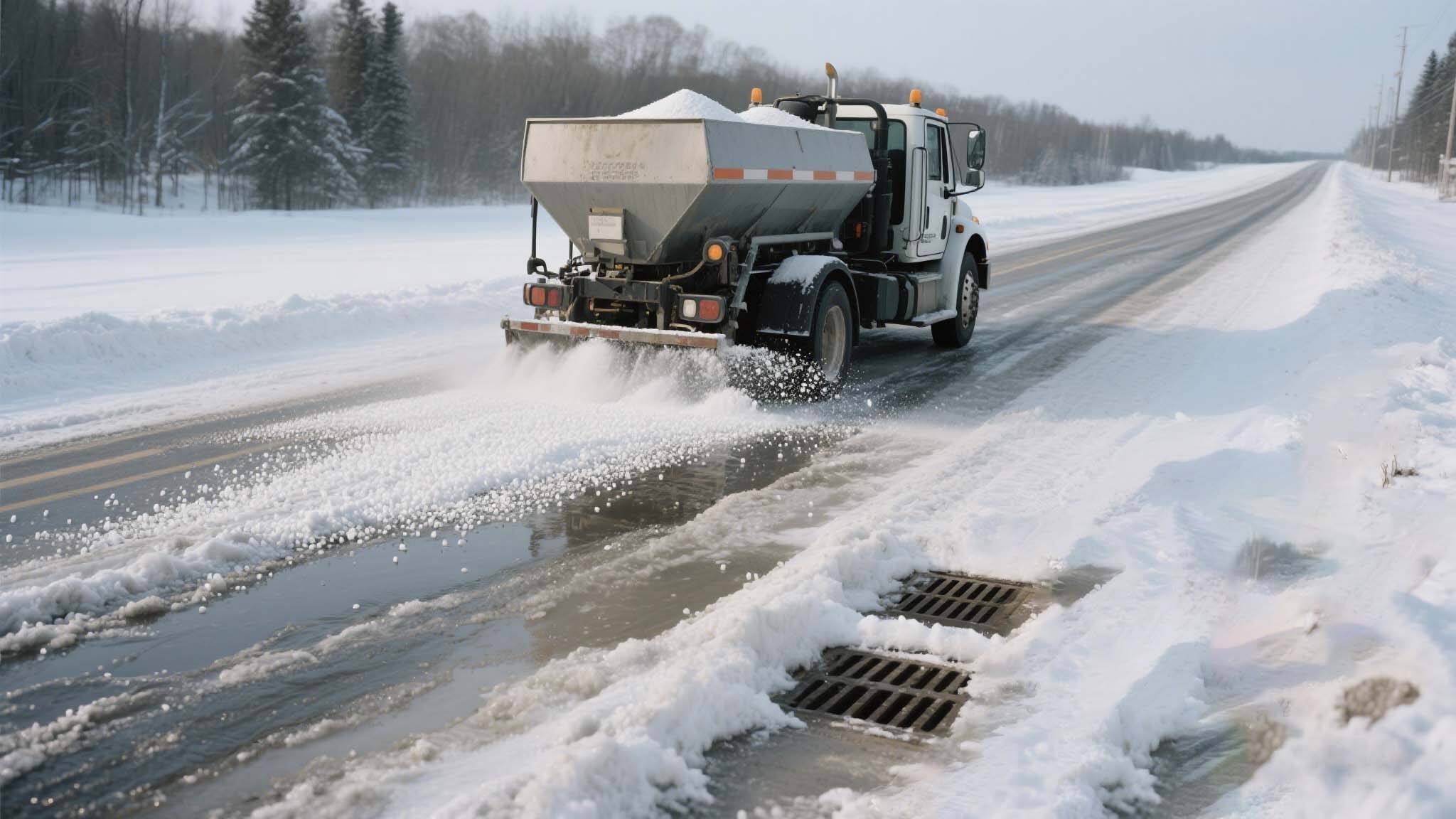مع قدوم الشتاء، تصبح سلامة طرقنا واحدة من أهم مخاوفنا. يعتبر كلوريد الكالسيوم مركبًا مفيدًا يستخدم في إذابة الجليد على الطرق أثناء الطقس البارد. فهو يلعب دورًا مهمًا في تحسين سلامة الطرق عن طريق خفض نقطة تجمد الماء لمنع تراكم الجليد على الطرق. في هذا المدونة، سنتعلم الفوائد التي يقدمها كلوريد الكالسيوم، وكيف يعمل، ولماذا يتم تفضيله لصيانة الطرق في الشتاء.
فهم كلوريد الكالسيوم
على الرغم من اعتياد البعض على تسميته ملح الصخور، فإن كلوريد الكالسيوم (CaCl2) هو مركب ذو تركيبة مختلفة يستخدم لذوبان الجليد عن الطرق أثناء الفترات الباردة. لديه قدرة على إذابة الجليد في فصل الشتاء، وامتصاص الرطوبة من المناطق المحيطة. هذا يعني أنه بالإضافة إلى خفض درجة حرارة الماء، فإنه عند وضعه على الطرق فإنه يشكل محلولاً مالحاً قادرًا على إذابة الجليد والثلوج. هذه الخاصية، مقرونة بفعاليته عند درجات حرارة منخفضة، تجعله مستخدمًا في مختلف الولايات. ولكل هذه الأسباب، يعتبر كلوريد الكالسيوم ملحًا أكثر فعالية مقارنة بالملح التقليدي.
فوائد كلوريد الكالسيوم لسلامة الطرق
كلوريد الكالسيوم هو المادة المفضلة لزيادة سلامة الطرق بسبب فعاليته في منع تكوين الجليد على الطرق وبالتالي تقليل خطر الحوادث الناتجة عن الأسطح الانزلاقية. على عكس المواد الأخرى المستخدمة في إذابة الجليد، يبدأ كلوريد الكالسيوم العمل فوراً، مما يسمح بردود فعل أسرع أثناء العواصف الثلجية. هذا أمر حيوي للقيادة الآمنة خاصة في المناطق الحضرية المزدحمة.
بالإضافة إلى ذلك، فإن كلوريد الكالسيوم أقل تآكلاً من ملح الصخور (كلوريد الصوديوم)، مما يجعله أقل ضرراً للمركبات والبنية التحتية الأخرى. يعتبر مخططو المدن ومسؤولو صيانة الطرق هذا عاملاً حاسماً بسبب التأثيرات الاقتصادية الكبرى التي قد يكون لها التكاليف طويلة الأمد على إصلاح الطرق. يقدم كلوريد الكالسيوم للمunicipalities الفرصة لتحسين سلامة الطرق مع حماية أصول البنية التحتية.
تقنيات التطبيق
للحصول على فعالية قصوى، يجب تطبيق كلوريد الكالسيوم بشكل صحيح. يمكن نشره إما في شكل صلب أو كحل سائل. تحدد الظروف الشتوية المختلفة وشدة الطقس طريقة التطبيق. على سبيل المثال، معالجة الطرق مسبقًا قبل تساقط الثلوج يمكن أن تمنع تكون الجليد على الأرصفة، بينما المعالجة بعد التساقط يمكن أن تساعد في إزالة الجليد الموجود.
من المهم بنفس القدر جرعة كلوريد الكالسيوم. الجرعة غير الكافية لن تذيب الجليد بشكل كافٍ، والجرعة الزائدة قد تشكل خطرًا بيئيًا. لهذا السبب، تحتاج فرق صيانة الطرق إلى متابعة تقلبات درجات الحرارة لضبط طرقهم. هذه الممارسة لا تحسن السلامة فقط، بل تتماشى أيضًا مع الاستدامة البيئية في صيانة الطرق خلال فصل الشتاء.
الاعتبارات البيئية
استخدام كلوريد الكالسيوم في إذابة الجليد عن الطرق فعال، ولكن يجب أخذ تأثيراته البيئية بعين الاعتبار أيضًا. طالما يتم إدارته بشكل جيد، فإن المخاطر ليست خطيرة. على عكس كلوريد الصوديوم الذي يمكن أن يؤدي إلى تحلل التربة ويتلف النباتات، فإن كلوريد الكالسيوم يشكل تهديدًا أقل للحياة النباتية. ومع ذلك، يجب أن تظل البلديات مسؤولة عن استخدامها لمنع الآثار السلبية غير الضرورية على البيئة.
اتجاهات الصناعة والاتجاهات المستقبلية
من المرجح أن يزداد استخدام كلوريد الكالسيوم في صيانة الطرق الشتوية مع زيادة عدد البلديات التي تتبنى هذه الطريقة. كما أن التقدم التكنولوجي يدفع بهذا التغيير حيث أصبحت الأجهزة والتقنيات الحديثة للاستخدام أكثر كفاءة. التركيز المتزايد على المسؤولية البيئية ساهم أيضًا في تطوير مواد أخرى لإذابة الجليد تُستخدم مع كلوريد الكالسيوم لتعزيز منظومة السلامة الشتوية الشاملة للطرق.
بالمجمل، يُحسّن كلوريد الكالسيوم بشكل كبير من السلامة على الطرق خلال فصل الشتاء. فهو فعّال في إذابة الجليد، أقل تآكلاً، وأكثر صداقة للبيئة مقارنة بالخيارات الأخرى، مما يجعله خيارًا أفضل لإزالة الجليد عن الطرق. استخدامه بالاشتراك مع عناصر الطقس الأخرى يعزز من إدخال المرونة حيث يستمر في الامتثال لمُذيبات الجليد الموثوقة والفعّالة مثل كلوريد الكالسيوم. لا شك أن الاستثمار في مثل هذه التقنيات سيكون مثاليًا لضمان حركة أسهل على الطرق للجميع، خاصة خلال موسم الشتاء الصعب.


